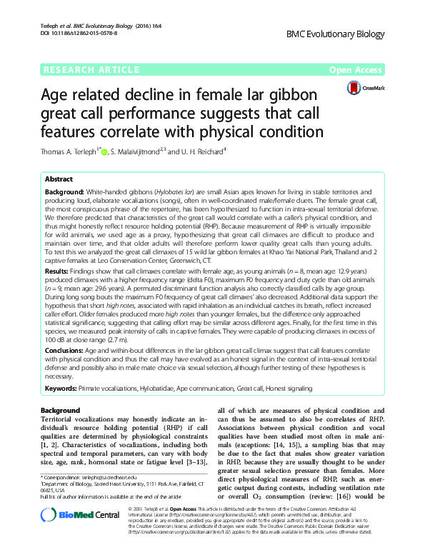
- Biology and
- Life Sciences
Background
White-handed gibbons (Hylobates lar) are small Asian apes known for living in stable territories and producing loud, elaborate vocalizations (songs), often in well-coordinated male/female duets. The female great call, the most conspicuous phrase of the repertoire, has been hypothesized to function in intra-sexual territorial defense. We therefore predicted that characteristics of the great call would correlate with a caller’s physical condition, and thus might honestly reflect resource holding potential (RHP). Because measurement of RHP is virtually impossible for wild animals, we used age as a proxy, hypothesizing that great call climaxes are difficult to produce and maintain over time, and that older adults will therefore perform lower quality great calls than young adults. To test this we analyzed the great call climaxes of 15 wild lar gibbon females at Khao Yai National Park, Thailand and 2 captive females at Leo Conservation Center, Greenwich, CT. Results
Findings show that call climaxes correlate with female age, as young animals (n = 8, mean age: 12.9 years) produced climaxes with a higher frequency range (delta F0), maximum F0 frequency and duty cycle than old animals (n = 9, mean age: 29.6 years). A permuted discriminant function analysis also correctly classified calls by age group. During long song bouts the maximum F0 frequency of great call climaxes’ also decreased. Additional data support the hypothesis that short high notes, associated with rapid inhalation as an individual catches its breath, reflect increased caller effort. Older females produced more high notes than younger females, but the difference only approached statistical significance, suggesting that calling effort may be similar across different ages. Finally, for the first time in this species, we measured peak intensity of calls in captive females. They were capable of producing climaxes in excess of 100 dB at close range (2.7 m). Conclusions
Age and within-bout differences in the lar gibbon great call climax suggest that call features correlate with physical condition and thus the call may have evolved as an honest signal in the context of intra-sexual territorial defense and possibly also in male mate choice via sexual selection, although further testing of these hypotheses is necessary.

This research was partially funded by a University Research/Creativity Grant (URCG) of Sacred Heart University, Connecticut.